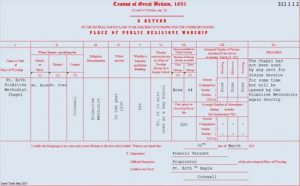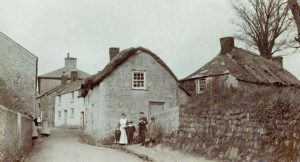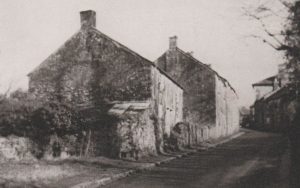Mapping Methodism – St Erth Primitive Methodist Chapel
Categories Mapping Methodism, Projects0 Comments
St Erth is a village four miles southeast of St Ives and six miles northeast of Penzance. This profile of St Erth Primitive Methodist Chapel has been compiled by Mike Millichamp and Tony Mansell
In 1796 the first Methodist chapel was built up at the cross where the post office is now. Before that a ‘hired’ room was used. This was used by the Wesleyans until 1827 after which it had various uses. By 1851 Independents and Bible Christians were using it for worship and it eventually became St Erth Bible Christian chapel, closing c. 1906. The Bible Christians were a Methodist group dating from 1815 and first appeared in St Erth in 1837. There were also Primitive Methodists, a group which was strong in the Midlands and the North of England; they were meeting for a time in St Erth about 1850. (St Erth Methodist Chapel http://www.st-erth.co.uk/methodist-chapel.html)
 Return from the Primitive Methodist chapel to the 1851 Census of Places of Public Religious worship. Return no: 311 1 1 2
Return from the Primitive Methodist chapel to the 1851 Census of Places of Public Religious worship. Return no: 311 1 1 2
The return from St Erth Primitive Methodist chapel to the 1851 Census of Places of Public Religious worship is unusual in that it reports that there were no services and no attendance on Census Sunday. The chapel, which it dates from 1839 and seating 64 with a further 200 standing “has not been used by any sect for Divine Service for some time but will be opened by the Primitive Methodists again shortly.” It was also in use as a day school. The return was completed by Francis Verrant, the proprietor of the chapel. The Prims may not have lasted long in St Erth. The 1886 Ordnance Survey map shows Wesleyan Methodist and Bible Christian chapels but not Primitive Methodist. (My Primitive Methodists) It is possible that the chapel had previously been used by the Bible Christians before they moved to the old Wesleyan Chapel in 1851.
A history of St Erth Primitive Methodist Chapel by Mike Millichamp
The Primitive Methodist Church split from the Wesleyan Methodist Church in 1810 to form its own church. There was a branch in St Erth but it is only the first and last Census of Places of Public Worship of 1851 and the Tithe Map of 1840 that help us to establish its identity.
The census declares that the purpose-built chapel dates from 1839 and could seat 64 with a further 200 congregation standing. It also stated that it had not been used by any sect for Divine Service for some time but would be opened by the Primitive Methodists again shortly. It was also in use as a day school.
The proprietor was given as Francis Verrant and the census returns of 1841 and 1851 show only one person with that name of an age that could be a preacher. The tithe map of 1840 shows that the same Francis Verrant was resident at the house with garden and a chapel.
Francis Verrant died in 1853 aged 77 and as the 1887 Ordnance Survey map does not show the chapel but does include the Wesleyan Methodist Chapel and the Bible Christian Chapel, it must be concluded that the building was no longer a chapel. A stroll up Church Street from Green Lane and about midway by glancing to your left you will pass the site where it once stood.
It is not known for how long the Primitive Methodists continued in St Erth without a dedicated building, as very little is recorded, but there is a newspaper report in 1901 when they attended a camp meeting on Trencrom Hill on a gloomy Sunday afternoon in July.
1839: Build date. (Census)
In use as a chapel. Possibly by the Bible Christians as Cedric Appleby states that they were meeting in St Erth from 1937.
Seating for 64 and for a further 200 standing. (1851 Census – Place of Public Religious Worship)
 1840 tithe map – plot 1607 is the Chapel (Courtesy Mike Mycetes)
1840 tithe map – plot 1607 is the Chapel (Courtesy Mike Mycetes)
 1840-42 extract indicates that plot 1607 already included a chapel (Courtesy Mike Mycetes)
1840-42 extract indicates that plot 1607 already included a chapel (Courtesy Mike Mycetes)
The tithe award for st Erth records a house, garden and chapel at st Erth (b1). Appleby notes that this was a Primitive Methodist chapel. There are no extant remains (b2). (Cornwall Council Heritage Gateway)
1851: Chapel to be re-opened and used by the Primitive Methodists. (1851 Census – Place of Public Religious Worship)
Closure date unknown but the 1851 census states that The Prims may not have lasted long in St Erth.
1886: No longer shown as a chapel on maps. (My Primitive Methodists)
July 1901: St Erth Primitive Methodists attended a camp meeting on Trencrom Hill. (Newspaper report)
 Church Street 1906 – chapel on left somewhere (Photo: courtesy Mike Mycetes)
Church Street 1906 – chapel on left somewhere (Photo: courtesy Mike Mycetes)
 Church Street (Photo: courtesy Mike Mycetes)
Church Street (Photo: courtesy Mike Mycetes)
 St Erth Church Street as old buildings demolished (Photo: courtesy Mike Mycetes)
St Erth Church Street as old buildings demolished (Photo: courtesy Mike Mycetes)
